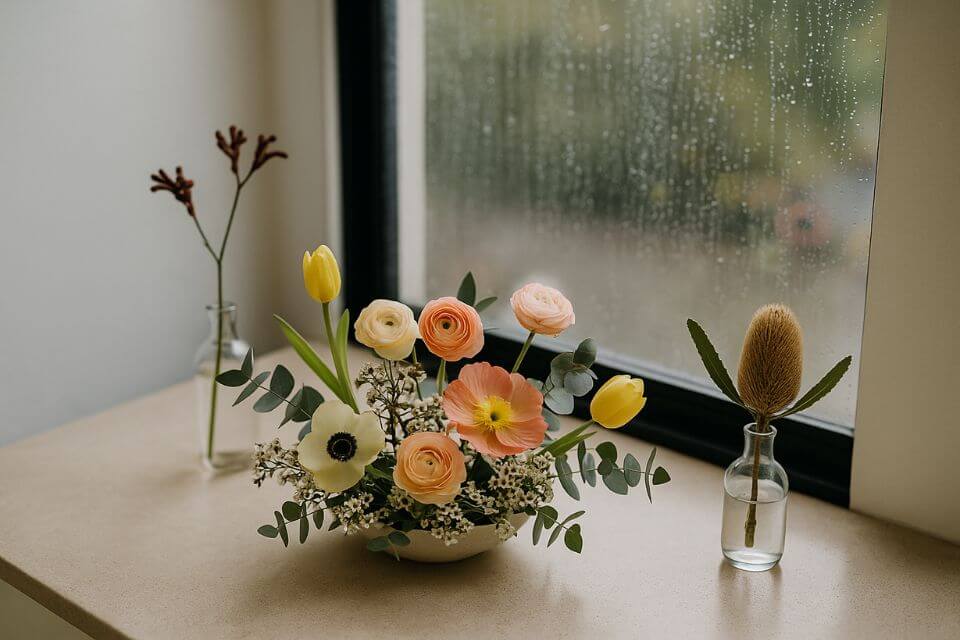Planning a funeral is an emotional and delicate process and choosing the right floral arrangements can bring comfort and beauty to a solemn occasion. However, when it comes to ordering floral sprays for a funeral, it’s important to understand the difference between casket and coffin arrangements. Many people use the terms “casket” and “coffin” interchangeably, but there are distinct differences between the two, and these differences can affect the type of floral sprays needed for the service.
In this article, we’ll explore the difference between a coffin and a casket, why it’s essential to inform your florist whether you’re ordering a casket spray or a coffin spray, and how these two types of floral arrangements differ in both design and purpose.
What is the Difference Between a Coffin and a Casket?
While both coffins and caskets serve the same purpose—to hold the body of the deceased during a funeral or burial—there are significant differences in their design.

- Coffin Design: Coffins have a distinct, tapered shape, with a wide area at the shoulders and a narrower area at the feet. This design is more common in Europe and Australia. Coffins are generally constructed to highlight the natural contours of the human body, which is why the top end is wider and the bottom is narrower. Coffins often have six sides.
- Casket Design: Caskets, on the other hand, are rectangular in shape and have four sides, providing a uniform design that is more common in the United States and Canada. They are typically larger and bulkier than coffins, with a hinged lid that opens from the side. Caskets are often lined with luxurious materials, making them a popular choice for those who prefer a more ornate or grand appearance.
Though both options serve a similar purpose, the difference in shape and size affects the type of floral arrangements that should be used to decorate them during the funeral service.
Why It’s Important to Tell Your Funeral Florist Whether You’re Ordering a Casket Spray or Coffin Spray
When ordering flowers for a funeral, the florist will need to know whether they are designing a floral spray for a casket or a coffin. This distinction is crucial because it directly impacts the size, shape, and style of the arrangement.
If you fail to specify the correct type of floral arrangement, the florist may design an arrangement that doesn’t fit the coffin or casket properly. For example, a casket spray that is too large for a coffin may overwhelm the smaller, tapered shape, while a coffin spray may not cover enough of a casket’s rectangular surface. In both cases, this can lead to an arrangement that looks out of proportion or awkward during the service.
Here’s why it’s important to make this distinction:
- Fit and Proportion: Casket sprays are designed to fit the wider, rectangular surface of a casket, while coffin sprays are longer and narrower to suit the tapering shape of a coffin. The florist needs to know which type of arrangement to create so that the flowers fit perfectly and look proportionate.
- Arrangement Style: The style of the floral arrangement will differ based on whether it’s for a coffin or a casket. Casket sprays tend to be more symmetrical and uniform, often cascading over the sides of the casket for a lush, full look. Coffin sprays, on the other hand, are typically more elongated and linear to follow the narrow lines of the coffin.
- Aesthetic Balance: Funeral flowers are meant to convey respect and peace, and a properly balanced arrangement can help achieve this. Informing your florist of the type of structure (coffin or casket) will allow them to design a spray that maintains visual harmony and contributes to the overall aesthetic of the service.
How Are Casket Sprays and Coffin Sprays Different?
Now that we understand the importance of communicating clearly with your florist, let’s dive into the specific differences between casket sprays and coffin sprays.
Casket Sprays
- Size: Casket sprays are generally larger than coffin sprays because they need to cover a wider, rectangular surface. They are designed to cover the entire length of the casket and often extend over the sides to create a full, draping effect.
- Shape: Casket sprays are typically designed in an oval or diamond shape to suit the uniform shape of the casket. The arrangement often features cascading flowers that flow over the sides, providing a lush, abundant appearance.
- Floral Composition: Casket sprays tend to include a wide variety of flowers and foliage to create a layered, textured look. Common flowers used in casket sprays include roses, lilies, carnations, and orchids, often arranged with greenery like ferns or eucalyptus to add volume.
- Placement: Casket sprays are placed directly on top of the closed casket during the service. If the casket will remain open for viewing, florists may design a “half-casket spray,” which only covers the lower portion of the casket, leaving the upper part open.
Coffin Sprays
- Size: Coffin sprays are generally smaller than casket sprays to suit the tapered shape of the coffin. They are designed to cover the length of the coffin without overwhelming its narrow structure.
- Shape: Coffin sprays are typically more elongated and linear, following the natural taper of the coffin. This helps to maintain balance and proportion. Unlike casket sprays, coffin sprays don’t usually cascade over the sides but instead focus on a streamlined, elegant appearance.
- Floral Composition: While coffin sprays can be just as beautiful as casket sprays, they tend to use fewer flowers and more linear arrangements. Flowers like calla lilies, gladioli, and long-stemmed roses are popular choices for coffin sprays due to their tall, elegant appearance. Greenery is also used but is often arranged in a more minimalist style.
- Placement: Like casket sprays, coffin sprays are placed on top of the coffin during the service. Since the coffin has a distinct taper, the spray is typically positioned along the top in a way that emphasizes its narrow shape.
Choosing the Right Floral Arrangement for a Funeral
Selecting the right floral arrangement for a funeral can be a deeply personal choice. Whether you are choosing a casket spray or a coffin spray, it’s important to consider the preferences of the deceased and their family, as well as the overall tone of the service.
Here are some factors to consider when choosing between a casket or coffin spray:
- Personal Preference: Some families may prefer a specific type of flower, colour palette, or style of arrangement. Be sure to communicate these preferences to your florist, who can tailor the arrangement to reflect the personality and tastes of the deceased.
- Cultural Traditions: Different cultures have different customs when it comes to funeral flowers. Some traditions may call for specific flowers or colours that hold symbolic meaning. If this is important to you, make sure to inform your florist so they can incorporate these elements into the arrangement.
- Budget: The size and complexity of the floral arrangement will impact the overall cost. Casket sprays, being larger, tend to be more expensive than coffin sprays. Your florist can help guide you to an arrangement that fits your budget without compromising on beauty or quality.
Conclusion
Whether you’re organizing a funeral or helping a loved one say their final goodbyes, understanding the difference between a casket and a coffin, as well as the corresponding floral sprays, is essential. By informing your florist of the specific type of floral spray you need—whether it’s for a casket or a coffin—you can ensure that the arrangement fits perfectly and contributes to a meaningful and beautiful service.
Floral arrangements that play an important role in honouring the memory of the deceased, and with the right guidance, you can choose a casket or coffin spray that brings peace, beauty, and comfort to all who attend the service.





